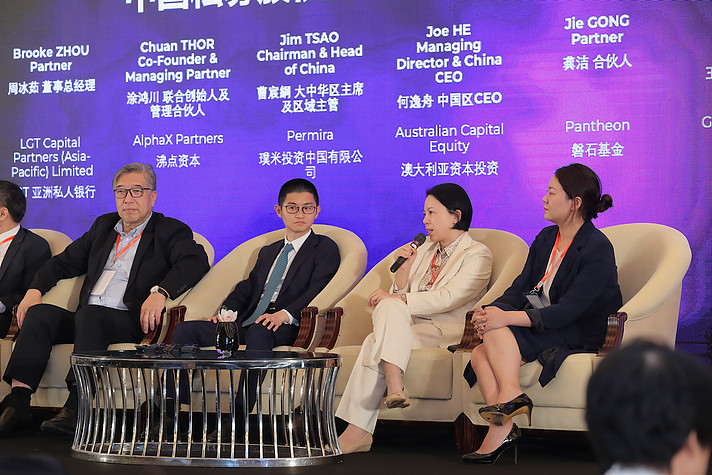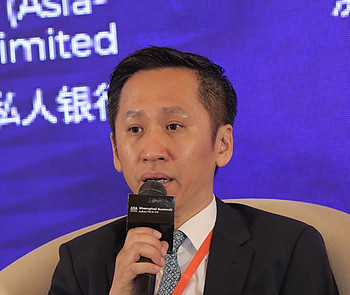Quest for Returns: China Private Equity
Is China still an attractive strategy for investors?
It’s a brave new world for private equity in China in current times. Thanks to the burgeoning wealth of entrepreneurs, corporates, fund managers and high net worth individuals, Asia Pacific is set to outpace the rest of the world to be the hub for global asset management, including private equity, in the coming years. With growth comes volatility and uncertainty, especially against the geopolitical backdrop of ongoing trade tensions.
We got together with Agnes Chen, Managing Director APAC at CSC Global Financial Markets, and some of the largest and most active LPs and GPs in China to talk about the state of private equity in China at the Asia Investment Conference in Shanghai on 24 October 2019.
Never mind the GDP indicators and political circus, real growth lies from within.
Despite macroeconomic headwinds and ongoing trade tensions pointing to slower growth, many investors continue to adopt a bottoms-up approach towards investments in China. Jie Gong, Partner at Pantheon, a USD 47 billion private markets fund manager, says that GDP is only but one economic indicator and prefers to construct a portfolio with a set of very solid growth drivers.
 |
“GDP development is not really a representative growth rate for a very wide range of industries and sectors. And we tend to focus on areas and pockets of market that have the growth trajectory far superior to GDP growth and our value-add is really zeroing in on those segments of the markets that have the most robust and interesting set of opportunities.”
Investors also believe that while looming trade tensions have largely impacted export-driven businesses, resilient domestic consumption will continue to underpin investor confidence and provide opportunities for GPs operating in China.
Joe He, CEO of Australian Capital Equity, one of Australia's largest investment groups investing in China for the last 20 years, believes that China is still good for a long-term play, citing a possible “Copy from China” trend whereby content in terms of both products and services originating from China could potentially be exported to other emerging markets in the rest of the world. He also mentioned that 20 years ago, a critical driver for achieving outsized returns from private equity investments in China involved the acquisition of relatively under-valued state-owned-enterprises. In today’s setting, a rising middle-class and digitisation of the economy has led to deals being negotiated and executed across a relatively more market-driven economy.
Chuan Thor, Founding and Managing Partner at AlphaX Partners, an early stage venture fund in China focused on technology, is also excited about the prospects for private equity in China, drawing reference to the technology gap between China and US which has dramatically narrowed over the last two decades.
 |
“In 1996 when I came to Shenzhen, China, we used to say that the technology gap between China and the US was over 10 years - China was 10 years behind the US. But in 2006, the gap was about 5 years. Today we think the gap is getting very close, and in some sectors, China has been doing much better than the US.”
Based on data from the World Intellectual Patent Organization ("WIPO"), patents filed by companies in Asia accounted for over two-thirds of applications filed in 2018, of which,m China took up the significant share. This growth in patent applications points towards how rapidly China is growing in terms of pursuing technological growth as compared to the more advanced economies in the US, Europe and rest of the world.
China-based GPs – currently still an entrepreneurial play.
GPs in China are likened to being entrepreneurs. The quality of business owners and startup founders 20 years ago had neither the experience nor capital to run their organizations effectively. Today, however, many local CEOs and management teams have successful track records of operating businesses, some even have the experience in taking companies public and investing in companies. From a venture point of view, Chuan believes that these indicators present very exciting times for investors as such trends were basically non-existent more than 10 years ago.
Brooke Zhou, Partner at LGT Capital Partners, a USD 60 billion fund-of-funds manager, commented that the funds being formed today in China - both private equity and venture capital - have the “perfect combination” of an on-the-ground local team, the connections, academic background and also international operating standards, largely obtained from their experience of having worked in banks, financial institutions and other private equity shops. That unique combination, coupled with the vibrant and consumer-driven domestic market, creates numerous exciting opportunities for the LP-GP landscape in China.
Outlook is promising but a long pathway to institionalization.
Based on reports from BCG and JPMorgan, M&A deals in Asia Pacific have significantly expanded from approximately 10% of total deal volume globally in 1996 to 20-25% in 2017. This significant shift in deal activity geographically has led to larger deal sizes in Asia, most of which are typically participated by global private equity titans such as Blackstone, KKR and Carlyle.
That said, all large PE players have their roots in starting out as a small local fund. Jim Tsao, Chairman and Head of China at Permira, a global GP with EUR 33 billion of committed capital, believes that unless local funds demonstrate that they can really do well in their home country, they would not have a place on the global stage.
 |
The investment approach of local funds tend to be more “EQ-driven”, especially in minority transactions where this is largely attributed to proprietary deal sourcing and the ability of the founders and team to get a good pricing on the deal. The larger global funds tend adopt a more “IQ-based” approach, in part due to the fact that the principles of investing are more systematic, auction-driven and applied across the firm globally. Larger funds also have the ability to achieve a consistent performance despite re-shuffling their management teams as they are able to pool their expertise and resources across geographies and industries. These attributes are not yet present in most China-based GPs owing to the fact that most local fund managers tend to have very divergent investment mandates.
Winter is coming?
Over the past few years, the surplus of capital has resulted in an increase in valuations and a potential asset bubble across China. Joe is cautiously optimistic on this. He believes that one of the most important principles to investing in companies and avoid the valuation trap is to weed out “false demand” in the market and really understand at the fundamental level, whether the target company solves an existing problem and satisfies a real market demand. Acquiring technology through acquisitions also offers an additional avenue for increasing productivity in Chinese companies, which is also in line with the government’s push for innovation and industrialization.
On the technology side, Chuan also believes that tech-driven investing in China will evolve from more consumer and Internet-centric companies such as the likes of Google and YouTube, to the more enterprise segment such as companies similar to Dropbox and Oracle. This trajectory is largely similar to the development of the tech companies in Silicon Valley during the early dot com days.
Technology (and disruption) permeates across all aspects of investing, from GPs to companies.
Xia Wang, Managing Director at one of the world’s largest and oldest alternative asset investors, GCM Grosvenor, believes that the pervasiveness of technology in China has led to 80% of funds in China being invested in technology and technology-enabled sectors ranging from healthcare, education, consumer market and business services.
Jie also commented that technology today permeates across all aspects of investing – from GPs to companies – and believes that investors today need to be quicker in adapting and responding to the changing market dynamics of an increasingly complex business environment. “Today, more than ever, you need to assess how this industry could be disrupted, and where that disruption can come from."
"Traditionally, you’d have a very clear view of the landscape and who the competitors are in the foresee-able future, but today there can be curve balls coming from another industry or from industries that currently have no overlap with your business.”
Another area where technology plays a part in value-add to a private equity deal are the analytics that go behind driving business and asset valuation. The abundance of data from widely available sources are more likely to influence the conversations between buyer and seller, and as a result, more GPs today are harnessing that to improve their negotiating position during the M&A process.
The single most important factor when investing in China-based GPs?
It can be difficult to use a single indicator as a benchmark to evaluate a GP, but ultimately, the team remains the most crucial aspect, which also encompasses stability, track record, GP commitment and overall alignment with LPs’ objectives.
On hindsight and comparing across the LP-GP deals that have done well against those that have under-performed, Brooke believes that it all comes down to GP motivation.
“You could have everything analyzed and due-diligenced but at the end of day, you still need a little bit of ‘luck’ to get the outsized returns!”
Jim remains optimistic on the outlook of Chinese PE market and believes that the landscape will eventually consolidate into a few big names, with the gaps between global funds and Chinese funds gradually narrowing in terms of investment approach and best practices.
Currently for the smaller local funds, people-skills and charms may be a couple of the most important factors in winning and executing deals. But as they grow in size, a stable team structure and an institutionalized set of execution processes will ultimately become the defining metrics for success.
As he puts it rightfully:
"Whoever who can get through those hurdles and deliver the results - and like every other industry in the world - number one in China will be number one in the world"
This article is a curated transcript of the panel discussion session "Quest for Returns: Private Equity in China" at the Shanghai Summit of the Asia Investment Conference. Watch the full recording here.
This article is written by Kenny Ng. He is an Executive Director and Founding Partner at IJK Capital Partners. https://www.ijkcapital.com/
Disclaimer:
Sponsored content: The views expressed in the post are those of the author.


